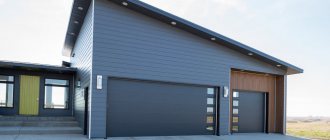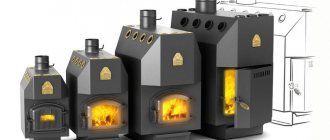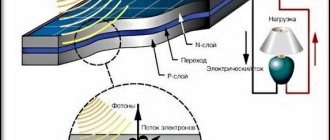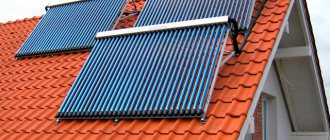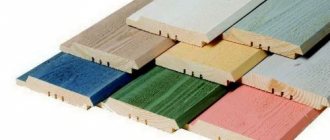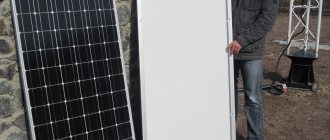Just recently, the very idea of free electricity seemed fantastic. However, technology does not stand still, and alternative energy is gaining more and more fans. More and more people are using the latest developments that allow them to gain autonomy without losing comfort. Solar panels are a truly efficient source of electricity under the right conditions.
So, what are these conditions and how effective can solar panels be in our climate zone?
What is a solar battery?
A solar battery consists of numerous photoelectric converters interconnected into a single system. They convert solar energy into electrical current.
Modern batteries can reach 40% efficiency. However, this requires appropriate conditions.
As a rule, it makes sense to install these systems in areas where there are sunny days most of the year. In addition, it is also worth considering the geographic latitude at which your home is located, because... When approaching the poles, the sun's ray loses some of its power. At the same time, if there are many sunny days in your region in winter, then solar panels can significantly reduce electricity consumption from the city grid.
Advantages and disadvantages of solar panels in space
Like any other high-tech equipment, photovoltaic panels for extraterrestrial space have advantages and disadvantages.
Pros:
- there is no atmosphere, rain or clouds outside the earth, the flow of solar radiation is constant, and therefore the panels generate current around the clock (with the exception of devices on the Moon and Mars);
- insolation in airless space is much higher, which increases the efficiency of using solar panels in space;
- in space photovoltaics, the efficiency reaches 40-45%.
Minuses:
- due to huge temperature changes, micro meteorites and hard cosmic radiation, the panels degrade faster;
- solar batteries for space cost a considerable amount on their own, and their delivery into orbit requires an additional 2-2.5 thousand dollars for each kilogram of mass;
- unfavorable operating conditions force the use of multi-level protection of all module elements, which makes them even more expensive and massive.
However, there is no worthy off-planet alternative to helio panels to perform the same tasks.
Types of solar panels
Solar batteries are divided into three large families:
- Thin film.
- Monocrystalline.
- Polycrystalline.
Related article: Pros, cons and installation of polystyrene foam baseboards
Thin Film Solar Cells
Thin film batteries consist of stretched films that can be easily installed in any convenient location. They are not afraid of dust and can work even in adverse conditions. In cloudy weather, their effectiveness is reduced by 20%. Inexpensive, but require a large area for installation.
Monocrystalline batteries
This type of battery is made from a large number of individual cells that are filled with silicone. Thanks to this waterproofing, they are effectively used in shipping. They can also be installed on roofs. Naturally, the sunny side of the roof will work more efficiently, but if for some reason it is impossible to install the batteries on the south side, you can move them to a more shaded slope. It must be remembered that diffused light is less effective.
Monocrystalline batteries have a relatively small mass and are compact in size. They are distinguished by flexibility, light weight, compactness, reliability and durability. Easy to install and dependent on direct sunlight. Moreover, even light cloudiness can lead to a cessation of energy production.
Polycrystalline solar cells
They differ from monocrystalline ones in that the cells contain crystals directed in different directions. This allows you to capture diffuse light and be less dependent on direct lighting.
These batteries are most familiar to us from illustrations. They are produced in the form of panels in a noble blue color. At the same time, they are somewhat cheaper than monocrystalline models. They are successfully used to illuminate houses, office buildings and even streets.
Space solar power plants of the future
Another incredibly promising area for the use of solar panels in space is the creation of large-scale orbital power plants in the near future. The reason for such interest in this project is the following:
- The power of the radiation flow from our star, directed towards the earth, is thousands of times greater than all the energy consumed by humanity.
- The placement of any number of solar panels in orbit is not limited in any way. Theoretically, they can form huge fields with an area of millions of square kilometers.
- Energy generation will occur in 365/24/7 mode, with the ability to transmit it to the ground via a microwave beam.
At the moment, the only obstacle to the implementation of such a project is its prohibitive cost. However, in the future, with the advent of technologies like the “space elevator”, putting cargo into orbit will become approximately 1000 times cheaper. And then the creation of such “SES of the future” can become a reality.
Why solar panels?
1. The sun is almost everywhere. As long as there is access to sunlight, electricity can be generated using these devices.
2. Autonomy. There is no need to connect to a centralized power supply system. Accordingly, you can reduce the overall cost of maintaining your home. There is no need to depend on the pricing policies of local energy magnates.
Related article: Interior of a small dark kitchen
3. When you need to supply electricity cables to remote villages and farms, it is sometimes much cheaper to install solar panels. Calculate the cost of the cable, poles, equipment and workers, and it turns out that with less red tape you can get the same service, and at the same time be your own boss.
4. Eco-friendly. This is the main advantage of this technology. There is no need to use fossil resources, which are known to be non-renewable. Photovoltaic cells do not produce carcinogenic emissions and do not increase the level of greenhouse gases. For their constant work there is no need to destroy already battered forest areas.
5. Lack of licensing. While the state has not yet made a decision on mandatory licensing for the production of electricity using photovoltaic cells, this can be taken advantage of. As you know, nothing is free for long.
Accessories for solar power plants
In order for the solar power plant to operate properly and fully cope with the assigned tasks at any time of the year and in any weather, it is necessary to competently approach the selection of components with which the modules are installed and connected. Today, all kinds of cables, connectors, crimping tools, as well as ready-made kits for fixing batteries are offered in a wide range, which allows you to choose the appropriate option in each individual case and guarantee the reliability of fixing the modules in a suitable place.
How justified is the use of solar panels for a private home?
Now count the number of sunny days in your area. Divide the cost of the equipment by 25 years and the calculated sunny days per year. And you will see whether it is worth using the installation data in your case. Also, consider the area required to generate 1 kW of electricity for your region. This can be found out quite easily from sales consultants offering solar panels.
Also take into account the period of the most active solar radiation. As a rule, in our latitudes this is the summer period.
Now think about the purposes for which you need electricity during this period.
- Lighting.
- Getting hot water.
- Operation of household appliances.
Related article: Features and tips for painting OSB boards indoors
A solar collector, which costs much less, can handle hot water, and any skilled owner can make it with his own hands. At the same time, it will be able to work in the autumn-winter season. At summer cottages and in the private sector, water heating tanks powered by the thermal energy of the sun have long been used to heat water in the summer.
But the solar battery will help you cope with lighting.
What the brochures don't tell you is that you will have to change the batteries regularly. And even the most efficient solar cell installation supplies electricity first to the batteries, and only then to the home’s power supply system.
By knowing the lifespan of conventional car batteries and their cost, as well as their capacity, you can find out how much it will cost to maintain solar panels. And more efficient specialized energy storage devices will cost much more and in the end will not cost you any less.
You also need to consider the efficiency of the models offered in your area. Not all of them can really work effectively in the Russian climate.
Although advertising says that the surface of the batteries is not afraid of dust, it is still clear to everyone that a battery covered with dust will work much less efficiently. And this will not extend the service life of its elements. Therefore, you need to take care of timely and regular cleaning of the panel surface.
Additionally, electronics may not work in hot weather.
Currently, these technologies are not available to all segments of society. However, current trends suggest that in the near future the existing shortcomings will be eliminated, and bright minds of pundits will come up with new ways to produce cheaper models that will be available to everyone.
pros
The use of solar energy already provides many advantages. The main ones:
- Free electricity. Immediately after installing and launching a home solar power plant, you will no longer need to pay electricity bills, because the sun will provide it.
- Silence. Unlike generators and other sources of electricity, the solar station operates absolutely silently.
- Long service life. Today, the average warranty length for solar panels reaches 25 years.
- Easy maintenance. All you need to do is regularly brush off dust and snow from the panels.
- Doesn't take up any useful space. Most panels are installed on the roof, where there is constant lighting during daylight hours. However, the battery can be installed on a hill, on a cleared plot of land - anywhere.
- Environmentally friendly. During operation of the panels, no harmful emissions or unpleasant odors are generated.
Of course, all these advantages are fully realized with the correct installation of solar panels. Therefore, it is worth carefully choosing a site for their placement.
Pros and cons of solar panels for the home
Pros and cons of solar panels for the home
Solar-powered gardening lamps: varieties
Depending on the size and type of site, landscape design and general design style, lamps can be used in different shapes, types of light dispersion and other characteristics. Let's look at the types of solar-powered garden lighting and their features.
Bollards
- Lamps in the form of pillars or bollards are the most common type of spot lighting for garden plots.
- This type is mainly intended for illuminating paths, paths, flower beds, garden figurines and other garden decorative elements where there is no need for bright and strong lighting.
- The height of the lamps can reach from 50 to 150 cm.
- The design of the light source can be very diverse, it all depends on the imagination of the manufacturer, starting from the standard classics - a spherical shape and a cone, ending with various silhouettes of figurines, bells, etc.
- Such lamps are easy to move; they can be taken out of the ground and stuck more tightly into the place where it will fully perform its functions.
- Most often, bollards are used when decorating areas in the style of high-tech and minimalism. These are columns extending from the ground with a luminous flux directed downwards.
Built-in lights
Such light sources are mainly needed to indicate the outline of an object. Usually they are installed along the perimeter of the path, in the ground, in the steps of the stairs, and are also used as illumination of various objects from below, for example, the facade of a building, sculptures, art objects, bushes, etc. Such lighting should not be too bright and powerful; it only highlights and illuminates an object or structure, so that in the dark you do not lose your way or pay attention to a certain object. Mostly built-in lamps use LED ones, but if you need to illuminate the façade of a building, you need a certain angle of inclination and a powerful beam of light so that the light falls as high as possible and can illuminate the entire length of the building.
Lamps for water structures
If you are the owner of a pond, pool or fountain, the illumination of such an object will look very beautiful
In addition, using such a design for a home pond is important from a safety point of view, because in the dark you can trip and end up in the water, even if you know your area very well. Orientation by touch in the twilight still will not protect you and your children from a possible fall. The backlight can be made either monochrome or multi-colored, and this is especially true for fountains. Lamps can be installed around the perimeter of a water structure or even under water. However, you should not place them so that the light falls directly on the water, as the beam of light will not penetrate into the depths of the water, and you will not get the expected charm from the scattering of lighting in a reservoir.
However, you should not place them so that the light falls directly on the water, as the beam of light will not penetrate into the depths of the water, and you will not get the expected charm from the scattering of lighting in a reservoir.
Decorative lamps
- Such lighting sources for a personal plot often serve simply as its decoration.
- The shape and color of lamps of this type can be very different. You can choose the shape of fairy-tale characters, garlands of birds located on trees or illuminated flowers.
- Solar-powered globe lamps look very discreet and elegant when the garden can acquire a galaxy style with the help of lamp shapes of various diameters placed at different heights.
Large lamps
- This type of lighting is generally mounted on a sturdy pole as they are quite tall and can function as large electric street lights.
- Their batteries are well protected from dust and moisture. Such flashlights are not a cheap pleasure, since there are powerful LEDs inside, which, when fully charged, can work for 3 to 4 days without interruption.
- The height of such a pillar can vary up to several meters. They work all year round, regardless of the time of year.
Wall lamps
- These lighting sources perform the same function as recessed lamps, but they also have their own characteristics. They should be installed in such a way that the sun's rays hit the surface as much as possible during the day, otherwise they will not have time to charge properly.
- When fully charged, a wall lamp can work for up to 10 hours, and if it’s a cloudy day, then such a light source will not be able to fully perform its function. The sunnier and brighter the day, the better the battery will charge.
- Such lamps are used to illuminate the walls of houses, garages, fences and other structures.
Popular models and brands of solar-powered lamps
With motion sensor
A convenient option for illuminating objects where light is needed when a person is present. The motion sensor allows you to turn on the light when a moving object enters the sensor's coverage area. If the function becomes unnecessary, then in most lamps it can be disabled.
Popular models with a motion sensor include the Chinese lantern Star Alliance YH0607A-PIR / Sanhoo 2LEDPIR and the Hungarian lamp Novotech Solar 357413.
Star Alliance YH0607A-PIR / Sanhoo 2LEDPIR
Star Alliance YH0607A-PIR / Sanhoo 2LEDPIR
Star Alliance is designed for wall mounting, the fastener is universal. The lamp shines in two modes: background and bright (when moving objects appear). Background mode can be disabled.
Solar panel power – 0.4 W, battery capacity – 400-500 mAh, IP44. Depending on the model, the number of LEDs and, accordingly, the brightness differ (from 40 to 150 lm).
Novotech Solar 357413
Novotech Solar 357413
Ground lamp with motion sensor. 28 LEDs provide illumination of an area of 5 m2. Lamp power is 2.5 W, color temperature 3000 K. IP54. Lamp height – 600 mm. Made of metal and plastic.
For the dacha
For beautiful illumination of country paths and decoration of the area, you can use decorative LED lamps “on a leg”. They are installed directly into the ground. If desired, they can be easily moved to another place, and can be easily stored for winter. Almost all models are equipped with photo relays, some with motion sensors. For example, the mentioned Novotech Solar 357413 is well suited for highlighting paths. Globo Lighting Solar 33839, 33271 and many other models are also popular.
Globo Lighting Solar 33839
Globo Lighting Solar 33839
Original Austrian lamp with built-in thermometer. The body is metal, the lampshade is plastic. Lamp luminous flux – 270 lm, illumination area 0.1 2, IP44. The stand is 37.7 cm high. A 3 V battery charge is enough for 8 hours of continuous operation. The lamp has two modes: manual and automatic (with photo relay). The price is about 2900 rubles.
Globo Lighting Solar 33271
Globo Lighting Solar 33271
Stylish appearance, stand height 68 cm. Metal body, plastic shade. Lighting area 0.1 m2, battery voltage 1.2 V, light bulb power 0.05 W, IP44.
For hiking
For tourists, the main thing is convenience. The lantern should be light and oversized. Often the solar battery is duplicated with built-in batteries or the ability to charge from a 220 V network. A good representative of camping lanterns is the SX-6800T/GH-5800T. It is inexpensive and equipped with 6 LEDs. The price is about 400 rubles. Charges both from the mains and from solar panels. Can be hung or used in the hand.
SX-6800T/GH-5800T
With USB connector
A convenient option for charging gadgets from the lamp. It is often used to illuminate camping lanterns, such as the G-85. It is similar to the SX-6800T/GH-5800T, but has a USB port for charging electronic devices. In addition, it can shine not only from a solar battery and a 220 V network, but also from ordinary batteries. 6 LEDs provide a bright light output. The battery capacity is enough for 5-9 hours of operation. Has a handle for hanging. Height is adjustable.
G-85 folded
Street lights
Street lights are more powerful than other types. They are equipped with many 0.06 W LEDs, so they shine brightly and over a large area
When choosing a street lamp, pay attention to the battery power (the more powerful, the better), the surface of the lampshade (it is better to choose corrugated glass)
Examples include the LC FIREFLY 4.5 V and Novotech Solar 358020 models.
LC Firefly 4.5W
Equipped with a motion sensor and photo relay. IP 54. Luminous flux 520 lm. Color temperature 6000 K. Charges in 6-8 hours, fully charged works up to 12 hours. Has different options for operating modes. The price is about 1000 rubles.
Novotech Solar 358020
Wall lamp, ip54. Lamp power 12.4 W. Luminous flux 500 lm. Color temperature 6000 K. Battery voltage 3.7 V. Plastic case.
